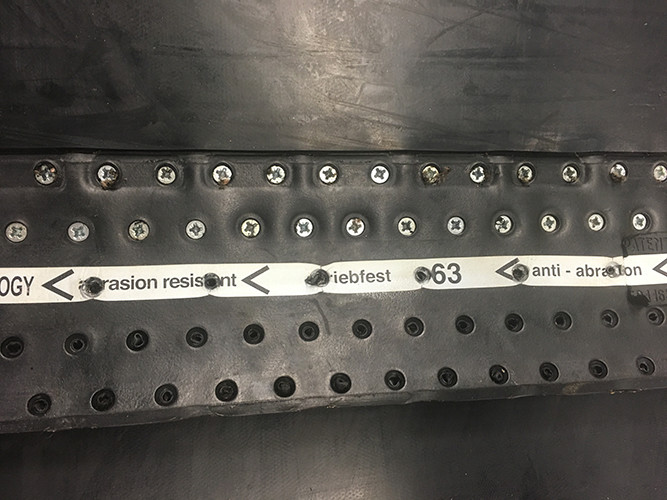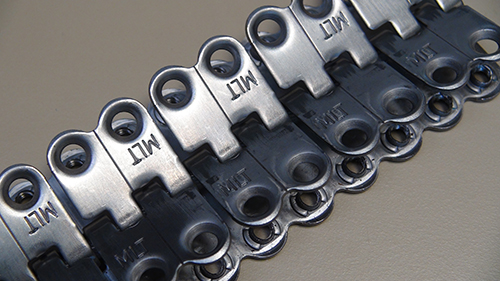Lacing - Belt Fabrications
The most common way of installing belting on conveyors is by Lacing. A laced splice is simple to attach to a belt with the proper equipment and easy to install on a conveyor. In order to achieve proper results the belting must be absolutely square and the proper size lacing must be installed. Following procedures incorrectly could result in the belt not tracking and/or lace failure. There are several manufacturers of lacing, such as Flexco or Minet. Use our Lacing Chart and the descriptions below to determine appropriate lacing. The FLEXCO Product Handbook outlines specific lacing products and tools.
Clipper
Individual clips are installed via a special machine with minimal damage to the belt and joined via a pin. It provides a smooth joint that is excellent for trough conveyors and small pulleys.
 |
 |
Clip N Lock
Individual clips are installed via a special machine with minimal damage to the belt and joined via a pin. It provides a smooth joint that is excellent for trough conveyors and small pulleys.
 |
 |
Unibar
Individual clips are welded together via common bar, installed with a special machine and joined via a pin. The common bar design prevents hooks from breaking away. Not recommended for troughing conveyors.
 |
 |
Alligator
Strips of steel with teeth are hammered into the belting and joined via a pin. A popular style for its ease of installation. Not recommended for troughing conveyors or small pulleys.
 |
 |
Staple
Strips of steel with teeth are hammered into the belting and joined via a pin. A popular style for its ease of installation. Not recommended for troughing conveyors or small pulleys.
 |
 |
MR Lacing
Strips of steel with teeth are hammered into the belting and joined via a pin. A popular style for its ease of installation. Not recommended for troughing conveyors or small pulleys.
 |
Plastic Rivet
Small plastic plates are installed with a machine and then joined via a non-metallic pin. This lacing is designed for areas where metal cannot be used such as metal detectors.
 |
 |
Spiral Lace
Polyester webbing is vulcanized or sewn into belt ends and then joined via a non-metallic pin. Used in X-ray machines or metal detectors.
 |
 |
Soft Seal Splice
Exclusive to PTFE belting this splice lacks metal fasteners to prevent damage to the material being conveyed.
 |
 |
Bolt Solid Plate
Steel plates are bolted together to form a belt splice. Inexpensive tools are used in the installation. Used in heavy duty applications.
 |
 |
Bolt Hinged
Solid plates are bolted together with inexpensive tools and the ends joins via a pin. Used in heavy duty applications.
 |
 |
Super Screw
A rubber filler is screwed through the belt with inexpensive tools. Used in heavy duty applications.
 |
 |
Rivet Hinged
Solid plates are riveted to the belt ends via a special tool and held together with a pin. Used in heavy duty applications.
 |
MS Lacing
Solid plates are screwed to the belt ends via a common tools and held together with a pin.
 |
 |
Rivet Solid
Solid plates are riveted to the belt while it is on the conveyor. A special tool is used to install this lacing. Used in extra heavy duty applications.
 |
Mulhern Belting can lace belting in any of several configurations:
Recessed Lacing
 |
 |
 |
Hidden Lacing
 |
 |
 |
Standard Lacing
 |
Cover Flap Lacing
 |

